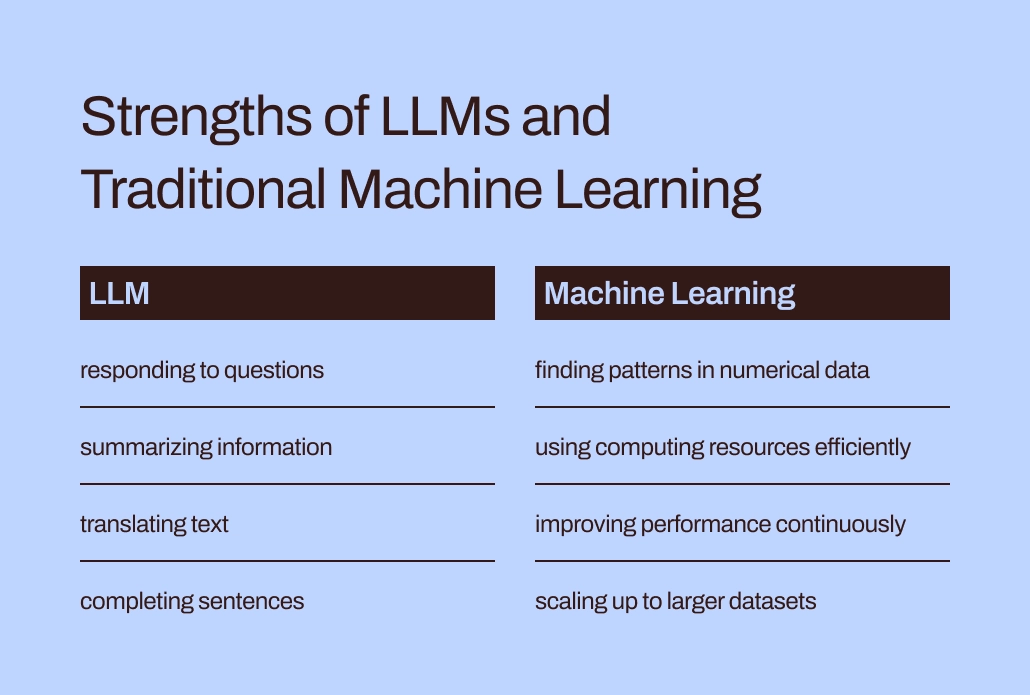In a nutshell:
- Large Language Models (LLMs) and data analytics collaborate to provide valuable insights and enhance business intelligence.
- LLMs are advanced generative AI systems that excel at processing and generating human-like text.
- Data analytics involves examining large volumes of data to uncover meaningful insights and drive decision-making.
- LLMs can be used to analyze textual data and extract valuable information, enhancing data analytics processes.
- The integration of LLMs and data analytics offers benefits such as improved contextual understanding, uncovering hidden insights, and enriched feature extraction.
It's true: We've finally found common ground for the AI enthusiasts who love words and those who love numbers, and it's where LLMs and data analytics intersect.
In the AI context, LLM stands for Large Language Model. LLMs are neural networks with multiple parameters. They are trained on large volumes of text data through semi-supervised learning.
The most well-known example of an LLM is ChatGPT. LLMs and data analytics work hand in hand to provide valuable insights. This connection turns them into essential tools for data leaders and professionals in various industries.
As LLMs become more and more complex, they continue supporting a wide variety of generative AI use cases that drive businesses forward.
In this article, we'll explore the collaboration between LLMs and data analytics, discover their individual importance, and learn how they can work together to enhance business intelligence — even helping generate predictions about the future.
Understanding LLMs: The Basics
Large Language Models are advanced artificial intelligence systems that excel at processing and generating human-like text. These models employ deep learning techniques and leverage extensive datasets to comprehend and generate natural language.
By training on massive amounts of data, LLMs develop an understanding of patterns, grammar, and context necessary for generating coherent and contextually relevant text. They possess the capability to:
- Comprehend prompts
- Engage in conversations
- Summarize information
- Produce creative pieces of writing
- Analyze text, video, and audio conversations
Over the years, LLMs have undergone significant changes. Beginning with early language models like Eliza and ChatGPT, advancements in machine learning and neural networks have led to developing more sophisticated models such as GPT-4 (Generative Pre-trained Transformer 4).
These models have grown in size and complexity, enabling them to handle a broader range of tasks and generate higher-quality text. A potential concern is the expense of using LLMs, particularly their cloud computing and sustainability impact:
"Using Large Language Models (LLMs) for data analytics has its challenges. One major drawback is the high cost associated with training and running LLMs, primarily due to the significant power consumption of numerous GPUs working in parallel." — Arham Islam
However, as LLMs become more refined and targeted to specific business challenges, their computing and power requirements will also diminish, making them more practical for various GenAI use cases at companies of different sizes.
What is the difference between GPT and LLM?
GPT (Generative Pre-trained Transformer) models are specifically designed for text generation, text completion, and various language-related tasks. LLMs (Large Language Models) are a broader category that includes different architectures such as Transformers, RNNs (Recurrent Neural Networks), and CNNs (Convolutional Neural Networks).
LLMs are designed to be scalable and versatile, with the choice of architecture depending on the specific objectives of the model.
While GPT models are focused on language tasks, LLMs encompass a more comprehensive range of applications, including data analytics and other non-language tasks.
The Importance of LLMs in AI
LLMs are crucial in advancing AI capabilities, particularly in natural language processing (NLP). They can potentially revolutionize various industries, including customer service, content creation, language translation, and more.
These models can automate tasks, provide personalized recommendations, and generate human-like responses. Their ability to comprehend and interpret vast amounts of textual data opens up new possibilities for leveraging AI in various applications.
Understanding Data Analytics: The Basics
Data analytics refers to the process of examining and interpreting large volumes of data to uncover meaningful insights, patterns, and trends. It involves applying statistical and analytical techniques to extract valuable information from raw data.
Data analytics aims to gain a deeper understanding of the data and use that knowledge to make informed decisions or drive improvements in various aspects of business operations.
Artificial intelligence and data analytics are related but distinct concepts. While AI involves the development of intelligent machines capable of performing tasks that typically require human intelligence, data analytics focuses on analyzing historical data to extract insights and drive decision-making.
Data analytics uses statistical techniques and algorithms to uncover patterns and trends within the data, enabling organizations to understand past performance and make data-driven decisions.
Data analytics is vital in modern businesses, impacting decision-making processes across various industries. Here are a few reasons why data analytics is crucial:
Improved Decision-Making
By analyzing historical data, organizations can identify patterns and trends, enabling them to make informed decisions based on evidence rather than intuition or guesswork. Data analytics provides valuable insights that can guide strategic planning, optimize operations, and enhance overall business performance.
Enhanced Efficiency and Productivity
Data analytics allows businesses to identify inefficiencies, bottlenecks, and areas for improvement. Uncovering hidden insights within the data allows organizations to streamline processes, allocate resources more effectively, and improve operational efficiency.
Personalization
Data analytics helps businesses better understand their customers by analyzing their behavior, preferences, and purchasing patterns. This knowledge enables organizations to deliver personalized experiences, targeted marketing campaigns, and tailored products or services. This results in increased customer satisfaction and loyalty.
Competitive Advantage
With data playing a significant role in successful business operations, organizations harnessing data analytics' power gain a competitive edge. By leveraging data insights, businesses can identify market trends, predict customer needs, and stay ahead of the competition.
Risk Management
Data analytics enables organizations to identify potential risks and mitigate them proactively. By analyzing historical data, businesses can identify patterns or anomalies that indicate potential risks or fraud, allowing them to take preventive measures and protect their assets.
LLMs and Data Analytics: The Intersection
The combination of LLMs and data analytics brings together the power of advanced language processing and the ability to extract insights from large volumes of data. LLMs can be utilized to analyze textual data, such as customer reviews, social media posts, or survey responses, and extract valuable information. By applying natural language processing techniques, LLMs can run sentiment analysis, identify key topics, and extract relevant keywords.
Modern LLMs have evolved to process and generate text and perform data analysis tasks. They can assist in data preprocessing, such as cleaning and organizing data, and even create visualizations to present data in a more digestible format. LLMs can identify trends, correlations, and outliers within datasets, enabling businesses to gain valuable insights and make data-driven decisions.
By incorporating LLMs into data analytics workflows, businesses can gain a more holistic view of their data, bridging the gap between structured and unstructured information. This integration allows for a deeper understanding of customer sentiments, market trends, and emerging patterns that might otherwise be missed.
The integration of LLMs and data analytics enhances business intelligence by providing a more comprehensive data analysis. LLMs can process unstructured text data, such as a sales rep’s conversation with a prospect, and extract valuable insights.
These insights can then be combined with structured data, such as sales figures or demographic information, to create a more complete picture of customer behavior, market trends, and business performance.
By implementing LLMs into data analytics processes, businesses can unlock the potential of unstructured data, enabling them to make more informed decisions.
Overall, this tandem usage boosts business intelligence by leveraging the power of language processing and data analytics to drive strategic decision-making and foster growth.
The Power of LLMs in Predictive Analytics
Predictive analytics is a branch of data analytics that utilizes historical data, statistical algorithms, and machine-learning techniques to forecast future trends, behaviors, or outcomes.
By analyzing patterns and relationships within the data, predictive analysis aims to make accurate predictions and inform decision-making processes. It enables businesses to:
- Anticipate customer behavior
- Identify potential risks
- Optimize operations
- Gain a competitive edge
LLMs can play a significant role in predictive analysis by leveraging their language processing capabilities. While LLMs are not specifically designed for numeric data analysis, they excel in processing and generating textual information. They can analyze large volumes of text data to extract insights that can be used in predictive modeling.
LLMs can assist in identifying relevant features, sentiment analysis, and understanding the context of textual data, which can enhance the accuracy and depth of predictive analysis. The integration of LLMs in predictive analysis offers several benefits for data-driven businesses:
Enhanced Contextual Understanding
LLMs can provide a deeper contextual understanding of textual data, enabling more accurate predictions. They can identify sentiment, detect nuances, and interpret the semantics of written content. This, in turn, can improve the accuracy of predictive models.
Uncovering Hidden Insights
LLMs can uncover hidden patterns, trends, and relationships within textual data that may not be apparent through traditional data analysis techniques. By incorporating LLM-generated insights into predictive models, businesses can gain a competitive advantage and make more informed decisions.
Enriched Feature Extraction
LLMs can assist in feature extraction from textual data, which can enhance the predictive power of models. By identifying relevant keywords, topics, or themes, LLMs contribute to the creation of more robust predictive models.
While they offer significant advantages in processing textual data, LLMs have limitations when it comes to creating predictive models using tabular (numerical) data. LLMs are primarily trained on textual data and may not be suited to handle numerical data or structured datasets. As a result, they may not reliably generate accurate predictions when working with numerical data.
To address this limitation, businesses may need to combine LLM-generated insights with other predictive analytics techniques tailored explicitly for numerical data analysis.
LLMs and traditional machine learning each have their strengths and should be used accordingly for business purposes.
How LLMs Can Be Used to Supplement Data Analytics
By combining the power of advanced language processing with data analytics techniques, LLMs can enhance the depth and accuracy of data analytics. Insights extracted by LLMs can then be integrated with structured data and used to inform decision-making processes. Some examples of using LLMs to supplement data analytics could include:
Sentiment Analysis for Customer Feedback
A company in the hospitality industry uses LLMs in combination with data analytics to analyze customer feedback from various sources, including online reviews and social media comments. By applying sentiment analysis techniques using LLMs, the company gains a deeper understanding of customer sentiments and identifies areas for improvement.
This analysis allows the company to make targeted changes to its services, resulting in improved customer satisfaction, increased positive reviews, and, ultimately, higher revenue.
Trend Analysis for Market Research
A retail company utilizes LLMs to analyze industry-related articles, blog posts, and social media discussions to identify emerging trends and consumer preferences.
The company gains valuable insights into market dynamics and consumer behavior by extracting key topics and sentiments from the textual data.
These insights enable them to adapt their product offerings, marketing strategies, and inventory management, resulting in increased sales and a stronger market position.
Risk Assessment for Financial Institutions
A financial institution employs LLMs and data analytics to assess potential risks in their loan portfolio. By analyzing textual data from loan applications, customer calls, and credit reports, LLMs identify patterns and indicators of possible default or fraud.
This integration of LLMs with data analytics allows the institution to make more informed decisions in approving or rejecting loan applications, reducing credit risk and improving profitability. In these examples, using LLMs in conjunction with data analytics can have a significant impact on business outcomes.
By leveraging the language processing capabilities of LLMs, companies extract valuable insights from textual data and apply them to improve customer satisfaction, identify market trends, and mitigate risks.
The Future of LLMs and Data Analytics
As the field of data analytics continues to evolve, the integration of LLMs holds immense potential for future developments. LLMs and data analytics are expected to undergo several advancements to further enhance their capabilities and impact various industries.
Improved Language Understanding
Future advancements in LLM technology will likely focus on improving language understanding capabilities. LLMs will become more proficient in recognizing context, sarcasm, idioms, and other linguistic nuances.
Multilingual and Cross-Cultural Analysis
LLMs are trained in multiple languages, but future developments will likely expand their multilingual capabilities. This will enable businesses to analyze and extract insights from textual data in various languages, facilitating global operations and cross-cultural analysis.
Real-Time Analysis
The future of LLMs in data analytics will involve real-time analysis capabilities. LLMs will be able to process and analyze textual data in real-time, allowing businesses to respond swiftly to emerging trends, customer feedback, and market dynamics.
Integration with Other Data Analytics Techniques
Future developments will focus on integrating LLM-generated insights with other data analytics techniques. By combining LLMs with traditional statistical models, machine learning algorithms, and predictive analytics, businesses can harness each approach's strengths and create more accurate predictive models.
Ethical and Bias Considerations
As LLMs' usage in data analytics becomes more prevalent, there will be an increased focus on ethical considerations and addressing potential biases. Future developments will improve transparency and fairness in LLM algorithms, ensuring that they do not perpetuate biases or discriminate against certain groups.
Other Concerns about LLMs and Data Analytics
What's the role for humans in analytics if AI takes over the job?
Some data professionals worry that these high-powered tools may undermine human expertise and intuition in complex problem-solving. After all, they do point to a new role for human judgment, creativity, and experience, raising concerns about problem-solving processes.
However, LLMs as used in data analytics should be viewed as a complementary tool rather than a replacement for human expertise. These models are designed to assist and enhance decision-making by quickly processing vast amounts of information and identifying patterns that may elude human perception.
Human intuition and expertise remain indispensable in interpreting results, contextualizing findings, and making nuanced decisions based on a deep understanding of complex situations.
This approach can empower humans to make more informed and strategic decisions in collaboration with advanced computational tools.
What if LLMs prioritize statistical patterns over important contextual information that humans would know to consider?
At the end of the day, LLMs and data analytics are powered by algorithms that analyze numerical correlations. However, the data context is nuanced, so some worry that a strictly numerical approach to data could produce incomplete or biased insights.
However, advancements in these technologies include efforts to address contextual nuances and improve the interpretability of results. Model training incorporates diverse datasets to capture a broader range of contexts. Ongoing research focuses on refining algorithms to better account for complex relationships within data.
Additionally, as we just explored, human oversight remains integral to interpreting results, allowing experts to factor in context, assess the relevance of statistical patterns, and ensure a more comprehensive understanding of the information.
How will the roles of data professionals change with the further integration of LLMs into data analytics?
It's unavoidable that there will have to be a redefinition of the skill sets for data analysts and data scientists. As these advanced models automate certain analytical tasks, there's a shift in the skills demanded from professionals in the field.
Traditional data analysts may find their roles evolving, requiring proficiency in working with LLM tools, understanding machine learning concepts, and adapting to new analytical methodologies.
Proactive upskilling initiatives are crucial. Organizations and educational institutions should invest in training programs that equip data analysts with expertise in LLMs, state-of-the-art data analytics, machine learning, and related technologies. This approach will help teams leverage the benefits of LLM technology while maintaining and enhancing their analytical capabilities.
Emphasizing continuous learning and adaptability will be key in navigating the evolving landscape of data analytics job roles.
How can generative and predictive AI techniques complement each other? Our CEO and co-founder, Zohar Bronfman, explains.
Pecan AI and LLMs with Data Analytics
Pecan's Predictive GenAI uses an LLM (generative AI) to help data analysts by providing a foundation for their predictive modeling projects. Then, traditional machine learning techniques take over, processing business data to create accurate predictions. This fusion of LLMs and traditional machine learning emphasizes the potential of both technologies, delivering more value to businesses.
LLMs and Data Analytics: Leveraging the Powerful Combination
LLMs and data analytics are vital tools in today's data-driven world. Their intersection has led to enhanced business intelligence and improved predictive analysis. Pecan AI is at the forefront of this integration, effectively combining the strength of LLMs with traditional machine learning to provide efficient, data-driven solutions. Join us in this exciting future of LLMs and predictive analytics by signing up for a free trial now, or get a guided tour.









